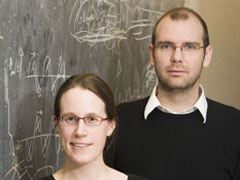Science and Tech Students Lauded
By Laura Pratt
Shawn Stapleton may spend his days peering at things from a very short distance, but he’s far-sighted enough to recognize the value of the Ontario Graduate Scholarship in Science and Technology (OGSST) with which he was recently honoured. Stapleton, who tracks changes in microcirculation in response to radiation therapy at Sunnybrook Research Institute (SRI), is one of 17 SRI students who received this prize. “I never expect awards,” the first-year PhD student shrugs. “But it’s always nice when you win one.”
Stapleton’s supervisor is Dr. Greg Czarnota, an SRI imaging scientist who’s interested in understanding the role that radiation therapy plays not only in tumour cells, but in the vasculature as well. He is also working with Dr. Peter Burns, a senior scientist in imaging at SRI and the chair of medical biophysics at the University of Toronto whose research is dedicated to being able to get quantitative hemodynamic information on the microcirculation, famously through the application of microbubbles.
“I’m ultimately striving [to be able] to measure a response to radiation therapy,” explains Stapleton. The employment of a contrast agent and the receipt of ultrasound-delivered information in real time (something that would be difficult with magnetic resonance or computed tomography imaging) are what make his research unique, says Stapleton.
“It’s quite an exciting project, and it’s on the frontiers of research in this area,” he says.
The scholarships are University of Toronto awards, granted to attract and support the brightest lights in the science and technology graduate student population. The program is supported through funds provided by the province of Ontario and monies raised by the university from the private sector.
The scholarships—$15,000 per year or $5,000 per term—are awarded in discipline areas defined by the ministry under the three broad headings of applied sciences, physical sciences, and—most relevant to SRI students—biological and life sciences.
Wendy Oakden is also thrilled about the fiscal injection the OGSST award makes to her life as a student. Her research is on the bright white spots that are revealed in magnetic resonance imaging in some older people’s brains, an unusual finding that is sometimes interpreted as a sign of a stroke, but largely misunderstood by scientists. “For my PhD, I am hoping to use lipid chemistry and an MRI scanner to figure out some possible causes for this. If we just knew what these spots of hyperintensity meant, we could develop a system for evaluating them.”
Oakden, like her prize-winning peers, will apply the gains to her student stipend. It’s a bonus, says Dr. Greg Stanisz, an imaging research scientist who is Oakden’s supervisor. “These funds allow students to pursue research full time. Having an OGSST frees up money in our lab budget to cover more time on the MRI scanner, and allows students to attend conferences, such as the International Society for Magnetic Resonance in Medicine meeting and exhibition, which will be held in Toronto next May.”
Indeed, says Stapleton, who has won this award twice before, in each of the years of his master’s degree. “Winning the OGSST allows me to be here in Toronto, and to do my research. I’m very grateful.”
PDF / View full media release »





